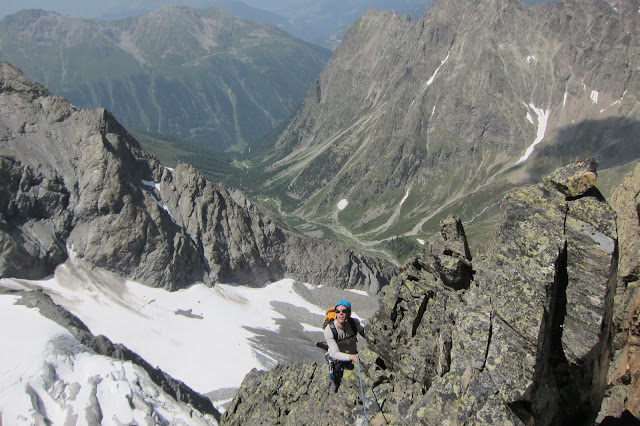Thursday afternoon we took the cablecar to Diavolezza station. From there, we followed the path towards Pers Glacier and decided for a campsite very close to the Furcla d'Arias. Access to water was close and on the ridge there were a few flattened and sheltered sites suggesting that the spot can be busy sometimes. Today it was quite. We are lucky!
The views from the campsite in the evening light were spectacular!! We enjoyed our dinner, and we could not take our eyes from the three prominent ridges of Piz Palue.
 From left to right: Piz Cambrena, Piz Palue (with eastern ridge, Bumiller ridge and western ridge), Bellavista.
From left to right: Piz Cambrena, Piz Palue (with eastern ridge, Bumiller ridge and western ridge), Bellavista.The next morning, we left the campsite at 4 am. We approached the base of the eastern ridge via the Pers glacier, meandering between the huge crevasses, in the moonlight. The moon was so bright, we could easily see the crevasses and the best ways to avoid them. It took us about an hour and a half to get to the base and there was something very special and magical about the tranquility and the moon escorting us.
The start of the climb is marked with two bolts and a few meters above you'll find a belay. We climbed the first few meters in the dark, and as we approached the ridge, it dawned and we could make out the crevassed glacier beneath us and in the morning sun Piz Bernina and Bianco ridge looked welcoming.
The climb was fun! More or less constant difficulties in grades II - III with some moves that were a little harder (IV), mostly on plates, a very few steep sections, but good solid holds throughout! The crux is a gendarme that can be climbed directly or climbed around to the left (east). We decided for the direct, bolted variante.
Roland preparing a belay just below the gendarme.
Looking back once more. Behind me the gendarme.
Once the tower is passed, the climbing becomes easier again, and soon we reached the snow-ridge. The snow was very firm and good to walk on.
The 45° angled slope and the ridge below.
On the eastern summit!
We reached the eastern summit around 10 am. Because the weather looked good for another few hours we decided to traverse the main summit and Piz Spinas and descend via Fortezza to the Pers glacier and back to our campsite. Last year, we traversed Piz Palü in the opposite direction (see http://stefanie-upandunder.blogspot.co.nz/2012/08/piz-palue-3901-m-west-east-traverse.html) and this traverse is absolute stunning!
The Fortezza offers a quite comfortable descent as the way through the rocks is well marked with yellow signs, and there are a few abseil rings if you don't feel quite as comfortable climbing down exposed steep sections (just as me ..).
Crossing the Pers glacier was okay, although the crevasses forced us to meander quite a bit. We were very close to our campsite, maybe 20 min away, when thunder rolled it and a few lightenings scared me. As we reached our campsite it started to hail, and we took down our tent, quickly packed our belongings, and ran off to Diavolezza station.
We made it safe to catch the cablecar at 4 pm, happy to be back from the mountain just in time, and filled with yet another thrilling mountain experience!





























.jpg)
.jpg)
.jpg)
.jpg)
.jpg)





